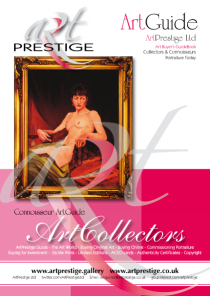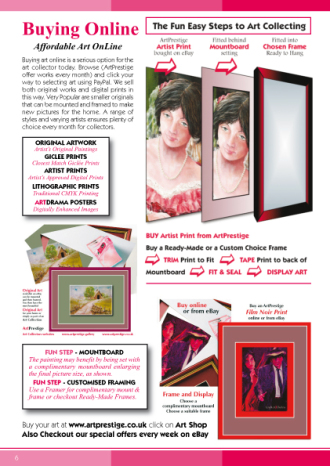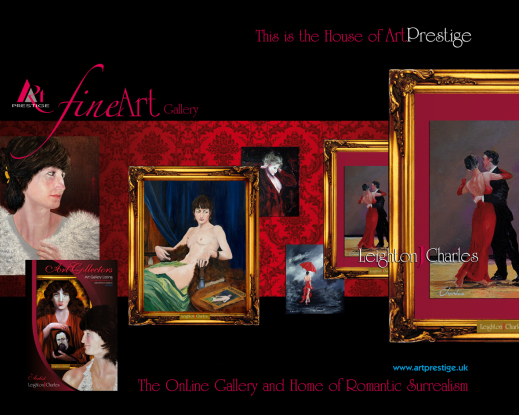The many Schools of Art
Barbizon School-Colour Field Painting-Conceptual Art-Cubism-Expressionism-Fauvism-Hard-Edge Painting-Hudson River School-Impressionism-Minimalism-Neo-Expressionism-Neo-Impressionism-Norwich School-Northern School-Op Art-Pop Art-Post-impressionism-Postmodernism-Realism-Surrealism-Symbolism-Vorticism.........and so it goes on.
These art schools and movements are forever irresistible. However we must avoid getting too precious about a particular movement. Even Dante Rossetti got fed up with the art
school that he invented, and is still celebrated today, of the PreRaphaelite Brotherhood. He became self-concious about it, finally abandoning the idea feeling it rather silly. We
love to put labels on things to help explain or simplify the detail. It is true that when we mention any of the art schools listed above we immediately think of practitioners and/or particular
pictures.
For example mention of Pop Art might make the reader think of the artist Roy Lichtenstein. The Art World loves its movements because it helps classify a work, as if it is explained
away by its very identification as belonging to a defined style or purpose. The identification of a school or movement somehow suggests that the work deserves merit simply because it is part of that
identified movement. Being attributed to an art movement helps assess the artist’s work in the context of personal objectives and beliefs. Schools of Art may help classification, dating and/or
contextualising nevertheless the prime factor in art appreciation will always be personal indentification with the work. In other words there is a connect between buyer and artist in that whatever it
was that inspired the original creation some of its meaningful stardust has filtered onto an audience that are similarly moved and appreciative.
Being in tune with an Artist is one of the great motivations for being your own Art Collector.
For example, this writer has a fondness for the French illustrator A.E.Marty whose work would fall into the Art Deco school encompassing the 1920's and beyond. This artist was used for numerous book illustrations and advertising and latterly prints and posters. The reason his work was/is so popular does not belong in classification or categorisation, rather it is due to his own imagination and ability to interpret a scene, paint with line and wash so beautifully as to render almost every piece of artwork uniquely his own.
The ArtPrestige ArtGuide
26-Page ArtGuide for Serious ArtCollectors
includes - PortraitureToday Supplement
READ NOW or DOWNLOAD
This fabulous ArtGuide explains the ArtPrestige Gallery and the platform of presenting Artists and Artisans work online in both Original and Reproductive formats. We outline the various options for printing both today and from the past. Giclée and Lithographic options explained and the acid test applied for all works of art under the ArtPrestige lable. Chapters include ART MOVEMENTS AND SCHOOLS, BUYING ART ONLINE, THE FUN EASY STEPS, GICLEE PRINTING, THE ARTDRAMA POSTERS and CERTIFICATES of AUTHENTICITY.
The 26-Page ArtGuide also includes an 8-Page PortraitureToday supplement - A beautiful examination of the process of portraiture for those considering the most unique and personal gift possible to bestow.
This ArtGuide was written and prepared in 2012
The next revised edition of the ArtPrestige ArtGuide is due to be released in 2017/18
Art Investment - The $12 Million Stuffed Shark
Extract from The Sunday Times.....
includes extract from the Don Thompson book The $12 million Stuffed Shark
At its heart, The Art World consists of three principle participants: The Artists, The Art Collectors and the Art dealers.
There are other players - such as Auctioneers, Art Fairs and Museums - but the relationship between the core triumvirate interests me the most. In theory, only the dealer is driven by the profit motive, but of course, many Art collectors also want to do well financially.
The sector is worth at least $60bn (£48bn) a year and is dominated by the US, Chinese and British markets. Art Dealers and private sales represent just over half of all sales.
About 40% of the market is Contemporary Art - A brilliant invention to expand the industry since Artists keep making more of it, and creating it often requires minimal craft while selling it just needs lots of hype.
I think certain Contemporary Art dealers are cynics. The book The $12 Million Stuffed Shark by Don Thompson reveals that of the 1,000 Artists who had serious Gallery Shows in New York and London during the 1980's, only 20 were still being shown in comparable Galleries in 2007.
In other words very little Contemporary Art will ever resell for even a fraction of its original purchase price. Yet many Dealers must surely convince their clients that the art they are buying is a good investment.
Luke Johnson is Chairman of Risk Capital Partners.
Extract from his article in The Sunday Times Business section 3 - 19th February 2017.
BUYING FOR PLEASURE and/or INVESTMENT
Art Collectors buying art, as with antiques, begs the question, are we buying simply for pleasure or investment. Naturally we want our purchase to increase
in value over time and be seen to be a prudent investment Is that the over-riding motive for buying or did we simply fall in love with the work with more altruistic intent or perhaps a combination of
the two factors and would it matter?
Art Collectors should buy their art for whatever reason and it is not for the Art World to dictate the actual value hierarchy, although they really do and in some ways can't help themselves. Where would we be without the Art Expert, the Art Critic and/or the Valuer? The Art World readily dictates art values based on the market place history or known sales history. Of course it is in their interest to create perceived values as if an exact science, which art, being subjective, can never really be. Art Collectors please note. At ArtPrestige we have sold Art for the pure pleasure it emits and buyers have been seduced to ownership aspirations by the sheer beauty of the image or painting. Others have bought simply for the speculation of a promising artist bringing considerable value to the original purchase at some time in the future. All is well and it is not for US or THOSE within the art world to sneer, dispute, disagree with customer choices or preferences. It works both ways - if a customer wishes to spend millions on an Andy Warhol print as valued by those within the Art World, that is and must remain their choice - and in that way the public ultimately determine what is art and what some of us are prepared to pay for it.
BUYING AFFORDABLE ART by Hugh St Clair
Contemporary broadly means work by living artists, even if they are now very old. Christie ‘s Auctioneers reorganised their Contemporary Art Department in 2000, and now they
distinguish between international artists from Post-Second World War years to the end of the 1960s, which come under the Post War category and then Contemporary Art, which is strictly applied to work
produced in the 1970s or later. While ‘contemporary’ has a relative, temporal meaning, ‘Modern Art’, on the other hand, tends to be characterised by a rejection of old subjects. In particular,
the term usually refers to art created from a period dating roughly from the 1860s to the 1970s. For example, by the end of the 19th century the church and religious foundations were no longer
important patrons of the arts.
This is an extract from the book Buying Affordable Art by Hugh St Clair - which we like.
Copyright of Original Artwork - including Portraiture
ArtPrestige Artists works are protected by Copyright in Law - this means that The Artist retains the 'Right' to 'Copy' his ORIGINAL Art Creation for the purposes of reproduction and that the buyer or purchaser of that ORIGINAL work of Art, whilst now owning the ORIGINAL is NOT entitled to 'Copy' or reproduce that artwork without prior permission from the 'CopyRight' owner - i.e the Artist. In simple terms a buyer may find that although owning, treasuring, benefitting from the investment return and enjoying possession of the ORIGINAL, he/she is not entitled to reproduce that artwork and make copies. The artwork buyer may well find themselves owning an ORIGINAL artwork that is indeed reproduced in the form of Prints being sold as the image remains within the Artist's custody and the legal right to create and sell prints and/or reproductions in some form.
Copyright and Reproduction
ArtPrestige Original Art, Artist's Copyright, Reproduction and the Protection of the Law
What is Copyright?
A bundle of intangible rights, granted by statute to the author or originator of literary or an artistic production, whereby, for a limited period, the exclusive privilege is given to that person
(or to any party to whom he or she transfers ownership) to make copies of the same for publication and sale. A copyright is a legal device that gives the creator of a literary, artistic, musical, or
other creative work the sole right to publish and sell that work. All Copyright owners have (by law) the right to control the reproduction of their work, including the right to receive payment for
that reproduction. An author may grant or sell those rights to others, including publishers or recording companies. Violation of any copyright is called infringement. Copyright must always remain
with the author or artist that created the original work of art.
In the case of portraiture the copyright must still remain with the artist. In practical terms this merely safeguards the artist ‘right’ to reproduce the image in print or digital form for the
purposes of further advertising or promotion of his services. Portraits are mostly highly personal images and therefore the reproduction value is limited; however there may be occasions where
portrait images (particularly themed settings) are required for book illustrations, displays or reproductions - particularly in the case of famous artists. In each and every case the copyright must
remain with the artist originating the portraiture artwork.
This protection need not concern customers and clients for portraiture.
The laws of copyright apply to every creative process by artists and artisans worldwide and have done since 1710. It is essential in these mass-media multi-communication times that the individual
artist is protected from the exploitation of their creative originality.
Much of the information here has been adapted from information found on the official website of the U.S. Copyright Office.
Copyright is a form of protection provided by the laws of the United States (Title 17, U.S. Code) to the creators of “original works of authorship,” including literary, dramatic, musical, artistic,
and certain other intellectual works. This protection is available for both published and unpublished works. Section 106 of the 1976 Copyright Act generally gives the owner of copyright the exclusive
right to do and to authorize others to do the following:
To reproduce the work in copies or phono records;
To prepare derivative works based upon the work;
To distribute copies of the work to the public by sale or other transfer of ownership, or by rental, lease, or lending;
To perform the work publicly, in the case of literary, musical, dramatic, and choreographic works, pantomimes, motion pictures and other audiovisual works;
To display the copyrighted work publicly, in the case of literary, musical, dramatic, and choreographic works, pantomimes, and pictorial, graphic, or sculptural works, including the individual images
of a motion picture or other audiovisual work; and
In the case of sound recordings, to perform the work publicly by means of a digital audio transmission.
In addition to copyright, certain authors of works of visual art also have the rights of attribution and integrity as described in Section 106A of the 1976 Copyright Act. It is illegal for
anyone to violate any of the rights provided by the copyright law to the copyright holder.
Who Owns Copyrights?
Copyright protection subsists from the time the work is created in fixed, tangible form.
The copyright in the work of authorship immediately becomes the property of the author who created the work. Only the author or those deriving their rights through the author can rightfully claim
copyright. The ownership of a book, manuscript, painting, or any other work does not give the possessor of that work its copyright. The law provides that transfer of ownership of any material object
that embodies a protected work does not of itself convey the copyright or any interest in the copyright. This remains in the possession of the creator and is often referred to as the underlying
artist’s copyright, distinct from the physical object which embodies it. Any or all of the copyright owner's exclusive rights or any subdivision of those rights may be transferred to another party,
but the transfer of exclusive rights is not valid unless that transfer is in writing and signed by the owner of the copyright or such owner's duly authorized agent. Such transfers are comparatively
rare in the U.S. and are almost never knowingly engaged in by European artists.
ArtPrestige Writers and Artists, Portraiture and the Laws of Copyright.
Art Galleries and Auction Houses
To HIGH STREET GALLERIES
We know that a lot of our Art Auction House Sales go to High Street Art Galleries as they naturally replenish stocks and source artworks from wherever.
ART GALLERIES
Giclée Prints - With this in mind, if any Art Gallery wishes to make contact directly with us, we can discuss the supply of Giclée Prints of ArtPrestige Artists.
CONNOISSEUR ART - If you have the client base to support Serious Connoisseur Art and the retail price that it sustains, please make contact, as we would be interested in supplying ORIGINAL Art for selective Galleries.
In the first instance please make contact:
Email to info@artprestige.uk
ArtPrestige UK - info@artprestige.uk
Making Contact with the ArtPrestige OnLine Gallery Artists, Writers and Artisans
UNDERSTANDING and CONSIDERATION
In issueing these contact points (email addresses) please be patient if replies are delayed.
We do not have management of Artist's personalities or their time. Some Artisans are famous for social media skills whilst others are notoriously reclusive. Remember the Creative Artist is many things, but nearly always abnormal, unpredictable and most certainly an individual.
ArtPrestige Email
info@artprestige.uk
ArtPrestige Artist & Writers Email
Desmond Piper Email - despiper@artprestige.uk
Aubrey Stax Email - stax@artprestige.uk
Sheridan Vaughan Email - sheridan@artprestige.uk
Leighton Charles Email - leighton@artprestige.uk
Gabriel Baxter Email - gabrielbaxter@artprestige.uk
Tony Brooks Email - Grapevine277@gmail.com
Ross Courtney Email - rosscourtney@artprestige.uk
Kathleen Conlon Email - kateconlon@talktalk.net
ArtPrestige Artists on Twitter
ArtPrestige is on twitter @artprestigeltd
Desmond Piper is on twitter @despiper
Leighton Charles is on twitter @theartisttalks
Leighton Charles is on twitter @artgallerypics
Gabriel Baxter is on twitter @kickoffweb
ArtPrestige Artists on FaceBook
Leighton Charles is on facebook
Des Piper is on facebook
ArtPrestige Artists on Pinterest
ArtPrestige is on pinterest
Leighton Charles is on pinterest







